非谓语动词情况下的ing及ed用法
非谓语动词做后置定语的三种形式
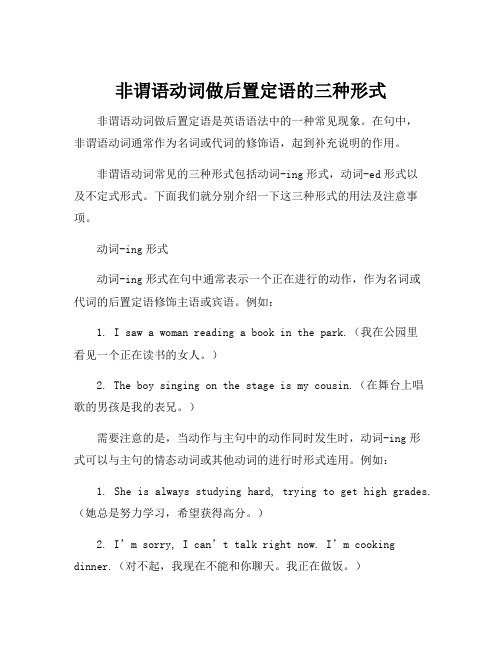
非谓语动词做后置定语的三种形式非谓语动词做后置定语是英语语法中的一种常见现象。
在句中,非谓语动词通常作为名词或代词的修饰语,起到补充说明的作用。
非谓语动词常见的三种形式包括动词-ing形式,动词-ed形式以及不定式形式。
下面我们就分别介绍一下这三种形式的用法及注意事项。
动词-ing形式动词-ing形式在句中通常表示一个正在进行的动作,作为名词或代词的后置定语修饰主语或宾语。
例如:1. I saw a woman reading a book in the park.(我在公园里看见一个正在读书的女人。
)2. The boy singing on the stage is my cousin.(在舞台上唱歌的男孩是我的表兄。
)需要注意的是,当动作与主句中的动作同时发生时,动词-ing形式可以与主句的情态动词或其他动词的进行时形式连用。
例如:1. She is always studying hard, trying to get high grades.(她总是努力学习,希望获得高分。
)2. I’m sorry, I can’t talk right now. I’m cooking dinner.(对不起,我现在不能和你聊天。
我正在做饭。
)动词-ed形式动词-ed形式通常表示完成的动作或对主语或宾语造成的影响或结果。
例如:1. The movie bored me. (这部电影让我感到无聊。
)2. The book written by the famous author was really good.(那个著名作家写的书非常好。
)需要注意的是,动词-ed形式还可以用来修饰某些情态动词或助动词,形成被动语态,例如:1. The letter has been written by my secretary.(这封信已经被我的秘书写好了。
)2. The house was built by my grandfather many years ago.(这个房子是我祖父很多年前建造的。
非谓语动词(动词ing形式和动词ed形式)课件

03
Hale Waihona Puke 动词ed形式可以作为状 语,表示动作发生的时 间、原因、条件等。
04
例如:He was born in 1990.(他出生于1990 年。)
动词ed形式与分词的区别
动词ed形式与分词在语法功能和用法 上存在显著差异。
例如:I have seen the movie.(我 已经看过这部电影了。)(动词ed形 式)
动词ing形式表示正在进行的动作或行为,而动名词表示已经完成或结果的状态。
动词ing形式在句子中做主语或表语时,表示一个动作或行为,而动名词则表示一个 名词概念。
03 动词ed形式
动词ed形式的构成
动词ed形式由动词原形加-ed构成,规则动词的-ed形式一般直接在词尾加-ed。 例如:work -> worked,play -> played。
表示被动关系
如"The book was written by him."。
表示习惯或经常性的行为
如"He likes reading books."。
表示时间或条件状语
如"If you study hard, you will succeed."。
动词ing形式与动名词的区别
动词ing形式既可以作为谓语的一部分,也可以作为独立成分,而动名词只能作为谓 语的宾语或表语。
非谓语动词的语态
主动语态
表示非谓语动词所表示的动作是 由句子主语发出来的。
被动语态
表示非谓语动词所表示的动作不 是由句子主语发出来的,而是被 其他人或物完成的。
非谓语动词时态和语态的用法
过去分词可以用于描述已经完成 的动作或存在的状态,常与时间 状语连用,如“已经”、“已经 完成”、“已经达到”等。
非谓语ing和ed做形容词

非谓语ing和ed做形容词
非谓语动词是指动词的非谓语形式,包括动词的现在分词(-ing形式)和过去分词(-ed 形式)。
这两种形式常常用来表示某一行为的状态或性质。
在英语中,非谓语-ing和-ed 可以用来做形容词,用于表达一个名词的性质或特征。
这种用法非常常见,我们可以在日常生活中的各种场合中见到。
-ing形式作为形容词,通常用来表示某个名词所处的状态或行为。
比如:
1. She had a boring day at work.(她上班那天很无聊。
)
2. The running water is so cold.(这流水太冷了。
)
3. I'm smelling something delicious.(我闻到了一些美味的味道。
)
在这些例句中,-ing形式修饰的名词分别是day(日子)、water(水)和something (某物),表示它们所处的状态或行为。
-ed形式做形容词
因为这两种形式都可以用来表达某个名词的性质或特征,所以他们也常常作为动词的补语或是形容词短语,例如:
3. She was fascinated by the scenery.(她被景色所吸引。
)
在这些例子中,-ed和-ing形式都充当了动词的补语,用来描述主语的感受或感受的对象。
这种用法可以使句子更加生动有趣。
总之,非谓语动词-ing和-ed做形容词的用法非常灵活,可以用来表示名词的状态、特征或经历,同时也可以作为动词的补语,使句子更加丰富、生动。
只需要不断地练习,就可以掌握它们的使用方法并增强自己的表达能力。
英语语法解析 动词-ing形式与动词-ed形式的区别
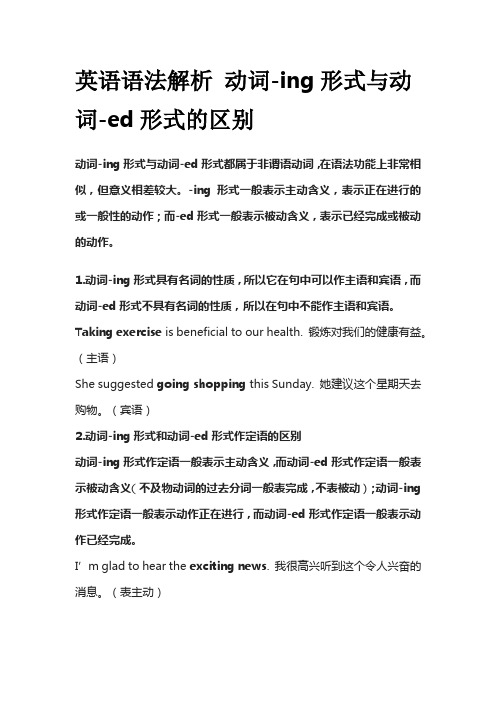
英语语法解析动词-ing形式与动词-ed形式的区别动词-ing形式与动词-ed形式都属于非谓语动词,在语法功能上非常相似,但意义相差较大。
-ing形式一般表示主动含义,表示正在进行的或一般性的动作;而-ed形式一般表示被动含义,表示已经完成或被动的动作。
1.动词-ing形式具有名词的性质,所以它在句中可以作主语和宾语,而动词-ed形式不具有名词的性质,所以在句中不能作主语和宾语。
Taking exercise is beneficial to our health. 锻炼对我们的健康有益。
(主语)She suggested going shopping this Sunday. 她建议这个星期天去购物。
(宾语)2.动词-ing形式和动词-ed形式作定语的区别动词-ing形式作定语一般表示主动含义,而动词-ed形式作定语一般表示被动含义(不及物动词的过去分词一般表完成,不表被动);动词-ing 形式作定语一般表示动作正在进行,而动词-ed形式作定语一般表示动作已经完成。
I’m glad to hear the exciting news. 我很高兴听到这个令人兴奋的消息。
(表主动)The cat drawn by the boy was very lovely. 男孩画的猫非常可爱。
(表被动)The ground was covered fallen leaves. 地上覆盖着落叶。
(不及物动词表完成)The rising sun is a symbol of hope. 冉冉升起的太阳象征着希望。
(表动作正在进行)They looked up at the risen sun. 他们仰望着已升起的太阳。
(表动作完成)3.动词-ing形式和动词-ed形式作表语的区别动词-ing形式作表语一般表示主语的性质和特征,含义为“令人……”;动词-ed形式作表语一般表示人的感受,含义为“(某人)感觉……”。
非谓语中分词的用法总结
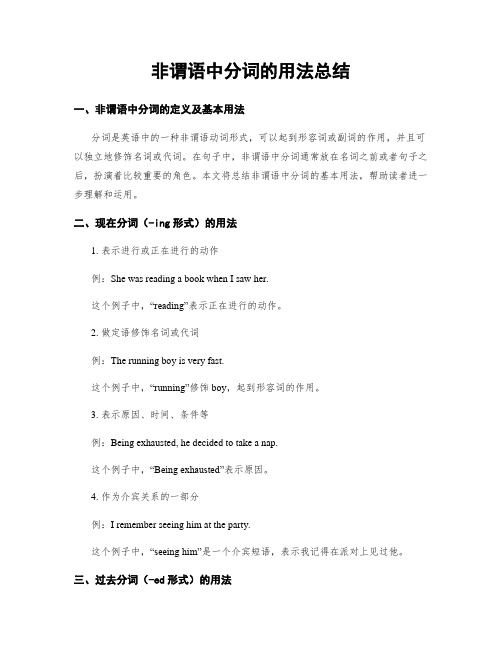
非谓语中分词的用法总结一、非谓语中分词的定义及基本用法分词是英语中的一种非谓语动词形式,可以起到形容词或副词的作用,并且可以独立地修饰名词或代词。
在句子中,非谓语中分词通常放在名词之前或者句子之后,扮演着比较重要的角色。
本文将总结非谓语中分词的基本用法,帮助读者进一步理解和运用。
二、现在分词(-ing形式)的用法1. 表示进行或正在进行的动作例:She was reading a book when I saw her.这个例子中,“reading”表示正在进行的动作。
2. 做定语修饰名词或代词例:The running boy is very fast.这个例子中,“running”修饰boy,起到形容词的作用。
3. 表示原因、时间、条件等例:Being exhausted, he decided to take a nap.这个例子中,“Being exhausted”表示原因。
4. 作为介宾关系的一部分例:I remember seeing him at the party.这个例子中,“seeing him”是一个介宾短语,表示我记得在派对上见过他。
三、过去分词(-ed形式)的用法1. 表示被动意义例:The window was broken by a stray ball.这个例子中,“broken”表示被动的意义。
2. 做定语修饰名词或代词例:I have lost my keys.这个例子中,“lost”修饰keys,起到形容词的作用。
3. 表示完成或完成的结果例:The report has been submitted.这个例子中,“submitted”表示完成了某个动作。
4. 作为介宾关系的一部分例:We had a lot of fun playing games at the party.这个例子中,“playing games”是一个介宾短语,表示我们在派对上玩游戏时度过了很多乐趣。
非谓语动词的六大用法
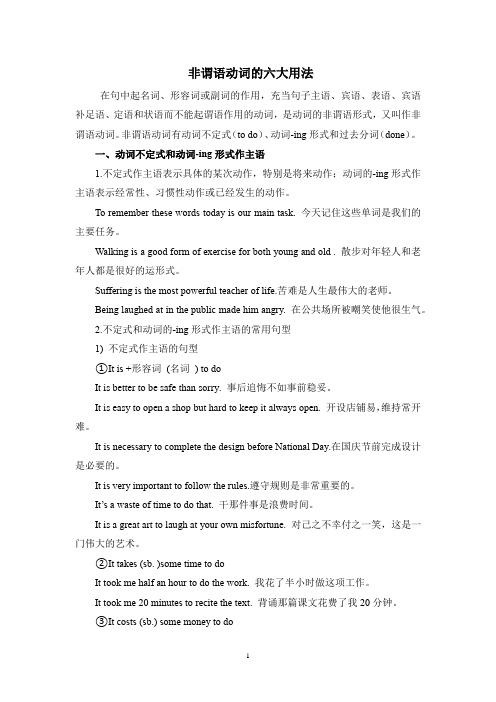
非谓语动词的六大用法在句中起名词、形容词或副词的作用,充当句子主语、宾语、表语、宾语补足语、定语和状语而不能起谓语作用的动词,是动词的非谓语形式,又叫作非谓语动词。
非谓语动词有动词不定式(to do)、动词-ing形式和过去分词(done)。
一、动词不定式和动词-ing形式作主语1.不定式作主语表示具体的某次动作,特别是将来动作;动词的-ing形式作主语表示经常性、习惯性动作或已经发生的动作。
To remember these words today is our main task. 今天记住这些单词是我们的主要任务。
Walking is a good form of exercise for both young and old . 散步对年轻人和老年人都是很好的运形式。
Suffering is the most powerful teacher of life.苦难是人生最伟大的老师。
Being laughed at in the public made him angry. 在公共场所被嘲笑使他很生气。
2.不定式和动词的-ing形式作主语的常用句型1) 不定式作主语的句型①It is +形容词(名词) to doIt is better to be safe than sorry. 事后追悔不如事前稳妥。
It is easy to open a shop but hard to keep it always open. 开设店铺易,维持常开难。
It is necessary to complete the design before National Day.在国庆节前完成设计是必要的。
It is very important to follow the rules.遵守规则是非常重要的。
It’s a waste of time to do that. 干那件事是浪费时间。
It is a great art to laugh at your own misfortune. 对己之不幸付之一笑,这是一门伟大的艺术。
非谓语动词中ING分词与不定式用法的区别
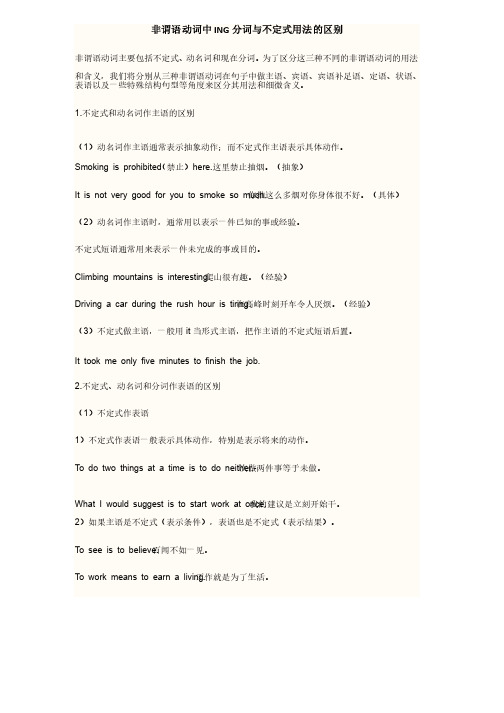
非谓语动词中ING分词与不定式用法的区别非谓语动词主要包括不定式、动名词和现在分词。
为了区分这三种不同的非谓语动词的用法和含义,我们将分别从三种非谓语动词在句子中做主语、宾语、宾语补足语、定语、状语、表语以及一些特殊结构句型等角度来区分其用法和细微含义。
1.不定式和动名词作主语的区别(1)动名词作主语通常表示抽象动作;而不定式作主语表示具体动作。
Smoking is prohibited(禁止)here.这里禁止抽烟。
(抽象)It is not very good for you to smoke so much.你抽这么多烟对你身体很不好。
(具体)(2)动名词作主语时,通常用以表示一件已知的事或经验。
不定式短语通常用来表示一件未完成的事或目的。
Climbing mountains is interesting.爬山很有趣。
(经验)Driving a car during the rush hour is tiring.在高峰时刻开车令人厌烦。
(经验)(3)不定式做主语,一般用it当形式主语,把作主语的不定式短语后置。
It took me only five minutes to finish the job. 2.不定式、动名词和分词作表语的区别(1)不定式作表语1)不定式作表语一般表示具体动作,特别是表示将来的动作。
To do two things at a time is to do neither.-次做两件事等于未做。
What I would suggest is to start work at once.我的建议是立刻开始干。
2)如果主语是不定式(表示条件),表语也是不定式(表示结果)。
To see is to believe.百闻不如一见。
To work means to earn a living.工作就是为了生活。
3)如果主语是以aim , duty , hope , idea , happiness , job , plan , problem , purpose , thing , wish 等为中心的名词,或以what 引导的名词性从句,不定式作表语是对主语起补充说明充说明 作用。
(整理版高中英语)新课程高考英语非谓语动词用法详解
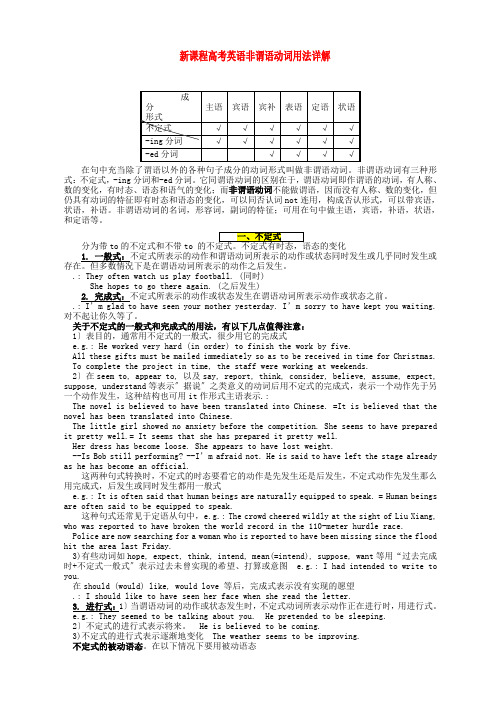
新课程高考英语非谓语动词用法详解在句中充当除了谓语以外的各种句子成分的动词形式叫做非谓语动词。
非谓语动词有三种形式:不定式,-ing分词和-ed分词。
它同谓语动词的区别在于,谓语动词即作谓语的动词,有人称、数的变化,有时态、语态和语气的变化;而非谓语动词不能做谓语,因而没有人称、数的变化,但仍具有动词的特征即有时态和语态的变化,可以同否认词not连用,构成否认形式,可以带宾语,状语,补语。
非谓语动词的名词,形容词,副词的特征;可用在句中做主语,宾语,补语,状语,和定语等。
分为带to的不定式和不带to1. 一般式:不定式所表示的动作和谓语动词所表示的动作或状态同时发生或几乎同时发生或存在。
但多数情况下是在谓语动词所表示的动作之后发生。
.: They often watch us play football. (同时)She hopes to go there again. (之后发生)2. 完成式:不定式所表示的动作或状态发生在谓语动词所表示动作或状态之前。
.: I’m glad to have seen your mother yesterday. I’m sorry to have kept you waiting.对不起让你久等了。
关于不定式的一般式和完成式的用法,有以下几点值得注意:1〕表目的,通常用不定式的一般式,很少用它的完成式e.g.: He worked very hard (in order) to finish the work by five.All these gifts must be mailed immediately so as to be received in time for Christmas.To complete the project in time, the staff were working at weekends.2〕在seem to, appear to, 以及say, report, think, consider, believe, assume, expect, suppose, understand等表示〞据说〞之类意义的动词后用不定式的完成式,表示一个动作先于另一个动作发生,这种结构也可用it作形式主语表示.:The novel is believed to have been translated into Chinese. =It is believed that the novel has been translated into Chinese.The little girl showed no anxiety before the competition. She seems to have prepared it pretty well.= It seems that she has prepared it pretty well.Her dress has become loose. She appears to have lost weight.--Is Bob still performing? --I’m afraid not. He is said to have left the stage already as he has become an official.这两种句式转换时,不定式的时态要看它的动作是先发生还是后发生,不定式动作先发生那么用完成式,后发生或同时发生都用一般式e.g.: It is often said that human beings are naturally equipped to speak. = Human beings are often said to be equipped to speak.这种句式还常见于定语从句中,e.g.: The crowd cheered wildly at the sight of Liu Xiang, who was reported to have broken the world record in the 110-meter hurdle race.Police are now searching for a woman who is reported to have been missing since the flood hit the area last Friday.3)有些动词如hope, expect, think, intend, mean(=intend), suppose, want等用“过去完成时+不定式一般式〞表示过去未曾实现的希望、打算或意图 e.g.: I had intended to write to you.在should (would) like, would love 等后,完成式表示没有实现的愿望.: I should like to have seen her face when she read the letter.3. 进行式:1〕当谓语动词的动作或状态发生时,不定式动词所表示动作正在进行时,用进行式。
- 1、下载文档前请自行甄别文档内容的完整性,平台不提供额外的编辑、内容补充、找答案等附加服务。
- 2、"仅部分预览"的文档,不可在线预览部分如存在完整性等问题,可反馈申请退款(可完整预览的文档不适用该条件!)。
- 3、如文档侵犯您的权益,请联系客服反馈,我们会尽快为您处理(人工客服工作时间:9:00-18:30)。
非谓语动词2分词
非谓语动词就是在句子中不充当谓语的动词。
它不受主语的限制,也没有像谓语动词那样的时态和语态的变化,又称为非限定动词,在句子中可以作主语、宾语、表语、宾补、定语和状语。
非谓语动词包括三种形式:不定式、动名词和分词。
1.分类:现在分词和过去分词。
2.用法:
(1)以ing 及ed结尾的adj的用法
由与感觉相关的Vt 得来,如: interest, bore, worry, surprise, frighten, delight, move, excite, tire, puzzle,disappoint, encourage, satisfy, please, inspire, astonish, discourage等。
这类动词的adj有两种:-ing “令人….的”,常修饰事物。
-ed “(人)感到…的”,常修饰人。
例:The children are all interested in the interesting story.
Exercise:1. Listening to the ______________report, we were all ______________(tire).
2. The film was so ______________ that the audience were deeply ______________(move).
3. Seeing the ______________ result, we are all ______________(delight).
注意:有些动词的过去分词转化为adj时,表示人的内心感受,有时还可修饰voice, look , expression 等名词,表示透过人的声音,表情显示出人的内心感受。
例:From his terrified voice,we can judge he really had a terrifying experience.
Exercise:1. The little boy seemed ______________at t he sight of the ______________snake(frighten).
2. How ______________it is to see a ______________ look on his face. (disappoint)
3. ______________of the ______________ film, the man went out of the cinema halfway.(bore)
4. He hadn’t expected the result, which can be seen from his ______________look. (surprise)
(2)做定语:现在分词做定语表示主动或正在进行;过去分词做定语表示被动或已完成。
A burning building A wounded soldier
单个的分词放在被修饰的名词前;短语分词放在被修饰的词的后面,相当于一个定语从句。
Do you know the boy standing by the door
Do you know the man called Bill Gates
Exercise:1. The man ______________(allow) to use the computer is the engineer.
2. The man ______________(allow) us to use the computer is the engineer.
3. There is a book ______________(leave) on the table.
4. There is a book ______________(lie) on the table.
(3)做状语:如果与句子的主语构成逻辑上的主动关系用现在分词;如果与句子的主语构成被动关系,要用过去分词。
The students went into the classroom, talking and laughing .
Seen from the top of the hill ,the city is very beautiful.
Exercise: 1. ______________ more time, we could do it much better.
2. . ______________ more time, they minister hope we can do it much better.
3. I hurried to the airport, only ______________(find)the plane had taken off.
4. ______________( notice) by the citizen, the theif was arrested finally.
(4)做宾语补足语:现在分词做宾语补足语表示宾语与宾语补足语之间构成主动关系;过去分词做宾语补足语表示宾
语与宾语补足语之间构成被动关系。
Jenny found a good way to have her written English improved in a short period.
She noticed something unusual happening.
Exercise:1. He could hear his heart ______________(beat)fast.
2. It’s terrible to hear your uncle ______________(send) to the hospital.
3. The teacher came in , with a book ______________(hold) in her hand.
4. The teacher came in , with a shy girl ______________(hide) behind her.
1.He said that he _______________(finish) the task in advance.
2.I’m worried about _______________ the news is true.
3.I once visited a factory _______________ was organised well.
4.I once visited a factory _______________ thousands of workers work.
5.______________ (consider) the distance, he arrived very quickly.
6.He showed he was ______________with the experiment results with a ______________look on his face.(satisfy).
7.I found my wallet ______________(steal).
8.The book ______________(write) in 1957 tells the struggle of the miners.。
